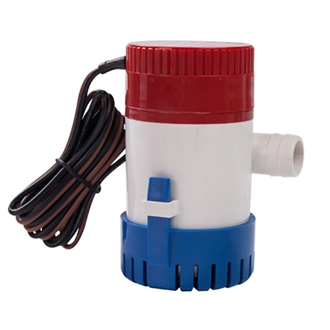How does a Bilge Pump Work?
The operation principle of a bilge pump, whether manual or electric, is pivotal to its functionality. Here's a detailed look at how these devices work, highlighting both centrifugal and positive displacement (diaphragm) pumps, the two most common types used in maritime environments.

Centrifugal Bilge Pumps
When activated, an electric motor spins an impeller. The spinning impeller creates centrifugal force, pushing water out through the discharge port. As water is pushed out, a vacuum is formed that draws more water into the pump through the intake port.
Mechanism
- Motor Activation: When the bilge pump is turned on, either manually or by a float switch, it activates an electric motor. The motor's shaft connects to an impeller housed within the pump body.
- Impeller Rotation: The impeller, which typically has multiple blades, spins at high speed. This rotation creates centrifugal force.
- Water Movement: As the impeller spins, it forces water outward to the edges of the pump body. This action expels water through the discharge port.
Flow Dynamics
- Creating a Low-Pressure Zone: The rapid spinning of the impeller not only pushes water out but also lowers the pressure at the center of the pump. This low-pressure zone creates a suction effect.
- Suction of Water: This suction pulls more bilge water into the pump through the intake port, continuously cycling the water out as the impeller spins.
Efficiency Factors
Centrifugal pumps are generally very efficient for moving large volumes of water quickly. However, their effectiveness can be reduced if the intake or discharge ports are clogged or if the impeller is damaged.

Positive Displacement Bilge Pumps
These pumps work by creating a vacuum to draw water into a chamber, then mechanically displacing it out. The flexing action of a diaphragm helps pull water in and push it out through the pump.
Mechanism
- Diaphragm Movement: In a diaphragm pump, the central feature is the diaphragm itself, which is a flexible membrane. The motor or manual mechanism moves this diaphragm up and down.
- Chamber Filling and Emptying: As the diaphragm moves down, it creates a vacuum in the pump chamber, pulling bilge water through the intake valve. When the diaphragm moves up, it compresses the chamber, pushing water out through the discharge valve.
Valve Operation
Check Valves: These are crucial in diaphragm pumps. The intake valve opens under the vacuum pressure when the diaphragm pulls down, and closes when the diaphragm pushes up. Conversely, the discharge valve remains closed during the intake stroke and opens during the compression stroke to allow water to exit.
Efficiency Factors
Positive displacement pumps are particularly effective at moving water against higher pressures and can operate more efficiently under a variety of conditions. They are also better suited for handling bilge water that might contain more debris or oil, as they are less likely to clog than centrifugal pumps.
Automatic Operation
Most modern bilge pumps are equipped with automatic functionality:
- Float Switches: These devices detect the water level in the bilge. When the water reaches a certain height, indicative of accumulating bilge water, the float switch activates the pump.
- Cycle of Operation: The pump continues to operate until the water level decreases to a preset low point, at which time the float switch turns the pump off. This automated cycling ensures the bilge does not overflow and that the pump operates only when necessary, conserving energy and reducing wear.
The operation of bilge pumps, whether by centrifugal force in impeller-based systems or by mechanical displacement in diaphragm pumps, is designed to efficiently manage the undesirable accumulation of water within a vessel. This ensures stability, prevents damage, and maintains the safety of the craft and crew.
Self-priming Principle of Bilge Water Pump
Bilge water pump is a kind of self-priming pump, its self-priming principle is to use the negative pressure generated in the pump body to draw water into the pump. When the water in the pump is pumped out, the negative pressure generated in the pump will bring the water in the suction pipe into the pump, thus realizing the role of self-priming.
In the self-priming state, the bilge pump can continue to pump water, without external water source, very suitable for use in the absence of water or unstable water source occasions.
Why Bilge Pumps Must be Self-priming Pumps?
- The use of bilge pumps: the bilge of the water is deeper, the length and slope of the pipeline is large, the flow rate is not enough, need a strong suction capacity of the pump. Self-priming pumps have just such characteristics.
- Self-priming pumps can avoid the problem of air clogging the inlet pipe when the ship is tilted, which ensures the normal work of the pump. If the ship is tilted, non-self-priming pumps will be due to the pipeline inlet is blocked by air, and then can not be normal pumping, while the self-priming pump can suck the water in the pipeline, still maintain normal working condition.
- Self-priming pumps eliminate a series of troublesome issues such as drainage and construction time of the pump room, speeding up the work process and shortening the downtime of the ship.
Overall, bilge pumps in order to meet the demand for stable and reliable pumping of water from ships in complex operating environments, it is necessary to use self-priming pumps with strong suction capacity, simple operation, easy construction and other advantages.

